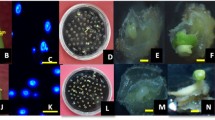Abstract
Isolated microspore culture techniques are being widely used in Brassica breeding programs to generate haploid and doubled haploid plants. A number of factors influence regeneration response in vitro including genotype. In order to assess the effect of genotype on microspore embryogenesis in B. rapa L. var. oleifera, 17 cultivars and breeding lines were evaluated. Embryos developed from all but one genotype when using NLN medium with 17% sucrose, followed by a reduction in sucrose concentration to 10%, 48 h later. The number of embryos /100 buds differed between genotypes, ranging from 0 to 70. Further studies indicated that sucrose concentration and incubation time influenced embryogenesis. Selection studies carried out with an Agriculture and Agri-Food Canada breeding line have resulted in the identification of a highly embryogenic B. rapa line. This line produced thousands of microspore-derived embryos /100 buds and will be useful in mutant selection and gene transfer as well as biochemical and developmental studies.
Similar content being viewed by others
References
Arnison PG, Keller WA (1990) Plant Breeding 104:125–133.
Baillie AMR, Epp DJ, Keller WA, Hutcheson D (1992) Plant Cell Rep. 11:234–237
Burnett L, Yarrow S, Huang B (1992) Plant Cell Rep. 11:215–218.
Cho MS, Zapata FJ (1988) Plant Sci. 58:239–244.
Coumans MP, Sohata S, Swanson EB (1989) Plant Cell Rep. 7:618–622.
Dunwell JM, Cornish M, Decourcel AGL, Middlefell-Williams JE (1985) J. Exp. Bot 36:1768–1778.
Dunwell JM, Thurling N (1985) J. Exp. Bot. 36:1478–1491.
Gamborg OL, Miller RA, Ojima K (1968) Exp. Cell Res. 50:151–158.
Govil S, Babbar SB, Gupta SC (1986) Plant Breed. 97:64–71.
Keller WA, Arnison PG, Cardy BJ (1987) Plant Tissue and Cell Culture, Green CE, Somers DA, Hackett WP, Giesboer DD (eds) Alan Liss Inc., NY, 223–241.
Lichter R (1982) Z. Pflanzenphysiol. 105:427–434.
Roulund N, Andersen SB, Farestveit B (1991) Euphytica 52:125–129.
Swanson EB, Coumans MP, Brown GL, Patel JD, Beversdorf WD (1988) Plant Cell Rep 7:83–87.
Swanson EB, Erickson LR (1989) Theor.Appl.Genet. 78:831–835.
Taylor DC, Weber N, Underhill EW, Pomeroy MK, Keller WA, Scowcroft WR, Wilen RW, Moloney MM, Holbrook LA (1990) Planta 181:18–26.
Taylor DC, Ferrie AMR, Keller WA, Giblin EM, Pass EW, MacKenzie SL (1993) Plant Cell Rep. 12:375–384.
Ulrich A, Furton WH, Downey RK (1984) Sci. Counc. Can. Rep.
Wei ZM, Harada H (1986) Theor. Appl. Genet. 72:252–255.
Yang Q, Chauvin JE, Herve Y (1992) Plant Cell, Tissue and Organ Culture 28:289–296.
Author information
Authors and Affiliations
Additional information
Communicated by B.E. Ellis
Rights and permissions
About this article
Cite this article
Ferrie, A.M.R., Epp, D.J. & Keller, W.A. Evaluation of Brassica rapa L. genotypes for microspore culture response and identification of a highly embryogenic line. Plant Cell Reports 14, 580–584 (1995). https://doi.org/10.1007/BF00231942
Received:
Revised:
Issue Date:
DOI: https://doi.org/10.1007/BF00231942



